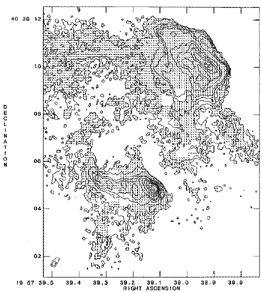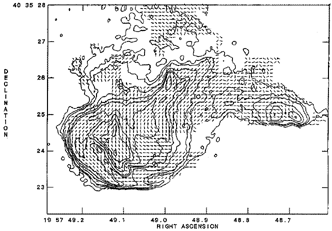


4.1. Structure: The Dentist's Drill
Hotspots in radio galaxies were first discovered in the occultation experiments of Swarup, Thompson, and Bracewell (1963). Since then hotspots at the source extremities have been a defining characteristic of FRII radio galaxies.
The high resolution images of the hotspot regions in Cygnus A are shown in Fig. 7. There are two hotspots in each lobe, designated A and B in the northern lobe, and D and E in the southern lobe (Hargrave and Ryle 1974, Miley and Wade 1971). The presence of multiple hotspots, and in particular compact `primary' hotspots (B and E, in the case of Cygnus A), and more diffuse `secondary' hotspots (A and D), appears to be common in powerful radio galaxies (Laing 1989, Lonsdale and Barthel 1986), although more complex morphologies are also seen (Black et al. 1992).

|

|
Figure 7. The contours show the total intensity at 15 GHz, 0.1" resolution of the southern (left) and northern (right) hotspot regions in Cygnus A (reproduced from Carilli, Dreher, and Perley (1989a). The contour levels are 2, 3, 6, 9, 12, 21, 30, 39, 48, 57 mJy/beam for the northern hotspot, and 2, 2.8, 4, 5.6, 8, 11, 16, 22, 32, 45, 64, and 91 mJy/beam for the southern hotspot. The line segments denote the direction of the projected magnetic field, derived from the polarized emission, after correction for Faraday rotation. We follow the nomenclature of Hargrave and Ryle (1974), who designated the large and small hotspots in the northwest lobe as A and B, and D and E in the southeast lobe, repectively. |
Early models to explain multiple hotspots in powerful radio galaxies
included complex shock structures in axisymmetric jets
(Norman et al. 1982),
and local instabilities along the contact-discontinuity
(Kronberg et al. 1977).
However, the generally accepted model today for multiple
hotspots is the `dentist drill' model, in which jets alter direction on
time-scales shorter than the timescale it would take for an `abandonned'
hotspot to fade to the background surface brightness level due to
expansion loses ( 105 yrs;
Carilli et al. 1988).
This model is consistent with a number of observations, including: lobes
which are wider than expected from axisymmetric models, primary hotspots
that are recessed from the ends of the radio lobes, and jets which are
not always straight from the core to the hotspot
(Williams and Gull 1985,
Carilli et al. 1988,
Williams 1991,
Cox et al. 1991,
Black et al. 1992).
In this model the primary hotspot represents the newest
hotspot where the jet impinges obliquely on the side wall of the radio
lobe, extending and widening the lobe in this new direction.
105 yrs;
Carilli et al. 1988).
This model is consistent with a number of observations, including: lobes
which are wider than expected from axisymmetric models, primary hotspots
that are recessed from the ends of the radio lobes, and jets which are
not always straight from the core to the hotspot
(Williams and Gull 1985,
Carilli et al. 1988,
Williams 1991,
Cox et al. 1991,
Black et al. 1992).
In this model the primary hotspot represents the newest
hotspot where the jet impinges obliquely on the side wall of the radio
lobe, extending and widening the lobe in this new direction.
The secondary hotspot could be explained by one of two models. First, the secondary may be powered by collimated outflow from the primary, i.e. the `splatter spot' model (Williams and Gull 1985, Smith 1984). An argument in favor of this model in some sources is that the projected magnetic field in the primary hotspot points towards the secondary hotspot (Lonsdale and Barthel 1986). However, the question remains: how to obtain such well collimated powerful outflow from the primary to the secondary, especially considering the large angles implied in sources like Cygnus A? One proposed solution is re-collimation of the post-shock primary hotspot fluid through a de Lavall nozzle (Lonsdale and Barthel 1986, Norman 1992), although the physical viability of such a solution has been called into question by a number of authors (Wilson 1989, Cox et al. 1991). This also leaves open the question: why is the total energy in the secondaries about an order of magnitude larger than in the primaries in most sources (Valtaoja 1984)?
An alternative model for powering the secondaries is to assume that the secondaries are the old hotspots, i.e. the location of previous jet termination. Besides the hotspot magnetic field structure already mentioned, the difficulties in this case are that the structure of the secondaries resembles that expected for a terminal Mach disk as discussed below, and that the spectra of the secondaries are consistent with current, or very recent, particle acceleration. A solution to these questions has been proposed by Cox et al. (1991) and Hardee and Norman (1990), in which the secondaries are still being fed by the remnant of the jet which has `broken' along its course. The 3D simulations of Cox et al. (1991) are particularly relevant, in that they show transient, and complex, hotspot structures at various times during the lifetime of the source, consistent with the myriad structures seen in hotspot regions in many powerful radio galaxies (Black et al. 1992).
In this second case, the well-developed secondaries may then correspond
roughly to terminal `Mach disks' predicted for axisymmetric jets. The
double-ridge structure seen at high surface brightness levels in both
hotspots A and D in Cygnus A has been modeled in detail by
Clarke et al. (1989).
They predict similar double structure in the terminal Mach
disk of a jet with a passive helical magnetic field, when the jet is
oriented at a small, but finite angle with respect to the sky plane
( 15°). Of course, the
simulations by
Clarke et al. (1989)
were in 2D. More recent work suggests that terminal Mach disks
tend to be very unstable when generalized to 3D, and that the more
likely scenario for a jet terminus is a series of oblique shocks
(Clarke priv. comm.).
Dreher (1981)
discusses hotspots in Cygnus A
and other radio sources and demonstrates convincingly that elongated
structures like the ridges in the Cygnus A hotspots are most-likely two
dimensional (disk-like), and not one dimensional (rope-like).
15°). Of course, the
simulations by
Clarke et al. (1989)
were in 2D. More recent work suggests that terminal Mach disks
tend to be very unstable when generalized to 3D, and that the more
likely scenario for a jet terminus is a series of oblique shocks
(Clarke priv. comm.).
Dreher (1981)
discusses hotspots in Cygnus A
and other radio sources and demonstrates convincingly that elongated
structures like the ridges in the Cygnus A hotspots are most-likely two
dimensional (disk-like), and not one dimensional (rope-like).
A final point that is relevant in the interpretation of the shock structures at the jet terminus in Cygnus A is the bow shock discovered in the rotation measure distribution by Carilli et al. (1988). The bow shock preceding the primary hotspot B in the northern lobe was detected via its contribution to the rotation measure distribution in this region. The bow shock is seen as an `arc' of discontinuous change in rotation measure (RM) roughly concentric with the primary hotspot, with a standoff distance of about 3". This jump in RM signals the point at which the thermal particles and tangential magnetic fields in the ICM are compressed by the shock due to the supersonic advance of the primary hotspot.
Detecting this radio quiet bow shock has a number of important implications on our understanding of source dynamics. First, it confirms the basic double-shock structure for the jet terminus in powerful radio galaxies and that the radio emission is contained within the contact discontinuity, at least in Cygnus A. Second, the fact that the bow shock projects onto the lobe dictates the three dimensional geometry of the source such that the primary hotspot B lies along the near-side wall of the radio source.